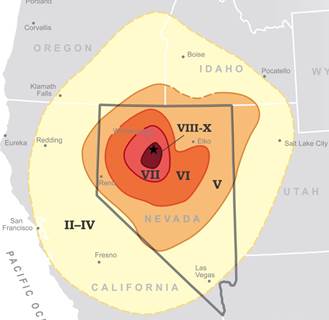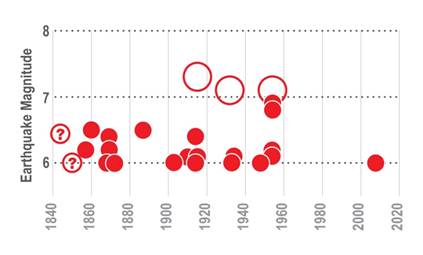Nevada’s Great 1915 Earthquake – Get Earthquake Ready
By Dr. Craig M. dePolo, Research Geologist,
Nevada Bureau of Mines and Geology (Nevada’s Geological Survey)
The Pleasant Valley earthquake of October 2, 1915 was the largest earthquake in Nevada’s recorded history. This earthquake ruptured the ground about 50 miles south of Winnemucca, and left a scar along the range front that was more than 35 miles long. In places, the ground surface was offset vertically by as much as 19 feet. The earthquake had a magnitude of 7.3 and was felt throughout Nevada. Damage occurred in many places, but was strongest in Pleasant Valley and in the towns of Kennedy and Winnemucca. This is the story of Nevada’s largest known earthquake and what it means to us.
Northern Nevada was very active geologically during 1914 and 1915. Magnitude 6 and 6.4 earthquakes occurred in Reno during February and April of 1914 and Mt. Lassen had several eruptions between May 1914 and October 1915, occasionally dusting Winnemucca with fine ash. The 1915 Pleasant Valley earthquake was preceded by a rare, highly energetic foreshock sequence that forecasted the ensuing large earthquake. When the foreshocks began is not exactly known as there were no recording instruments in the area. The first earthquake of note was a magnitude 5 at 3:40 p.m. October 2nd. This foreshock was distinctly felt in Winnemucca and as far away as Reno. Seismic activity continued into the evening. L. Roylance was in Kennedy, the community closest to the earthquake, and offered a description of the sequence (October 5, 1915 Silver State Newspaper - see page 2 of Living with Earthquakes in Nevada to read this account). Roylance portrayed a nearly constant sensation of earthquakes during parts of this foreshock sequence. The second foreshock of note was a magnitude 6.1 at 5:49 pm.
The mainshock occurred at 10:54 p.m. Shaking lasted for 40 to 55 seconds over a large area of northern Nevada. At Kennedy, people were “violently thrown out of bed and buffeted in all directions” according to Roylance. Nearly continuous aftershocks created nearly continuous ground motion in Kennedy for at least 15 minutes after the mainshock. Away from Pleasant Valley the motion was characterized as a “rapid series of swings, with little jerking or vertical motion” by Jones (Bulletin of the Seismological Society of America, 1915, v. 5, p. 190-205).
 Figure 1 is a map of the shaking effects from the earthquake, called a Modified Mercalli Intensity map. Areas with Intensity VIII to X had partially and totally collapsed buildings, surface rupture from fault movement, and ground cracking. Areas with Intensity VII had shaking strong enough to damage chimneys, within Intensity VI areas walls were cracked, and shaking in Intensity V areas was strong enough to awaken people. Strong shaking effects rumbled through a large portion of north-central Nevada and damage was reported in multiple communities. This is an important lesson from the 1915 earthquake. For earthquakes of magnitude 6 or larger, several locations may sustain damage and will need an emergency response.
Figure 1 is a map of the shaking effects from the earthquake, called a Modified Mercalli Intensity map. Areas with Intensity VIII to X had partially and totally collapsed buildings, surface rupture from fault movement, and ground cracking. Areas with Intensity VII had shaking strong enough to damage chimneys, within Intensity VI areas walls were cracked, and shaking in Intensity V areas was strong enough to awaken people. Strong shaking effects rumbled through a large portion of north-central Nevada and damage was reported in multiple communities. This is an important lesson from the 1915 earthquake. For earthquakes of magnitude 6 or larger, several locations may sustain damage and will need an emergency response.
The most devastating effects of the earthquake were to buildings on ranches in Pleasant Valley where total and partial collapses devastated some homes and barns. These ranches were above the earthquake fault plane, which projects beneath Pleasant Valley reaching the surface on the east side of the valley. Damage also resulted from an earthquake phenomenon known as liquefaction. Liquefaction occurs when saturated young sediments are shaken and consolidate. Liquefaction can cause water and sand to be expelled on the ground surface and form cracks. Sideways flow of the ground during liquefaction can distort overlying buildings. Roads were damaged by liquefaction in 1915. Although it can be said that the 1915 earthquake took place in a rural setting with only a half a dozen ranches in Pleasant Valley, 100% of the people in the Valley were severely impacted by the earthquake.
Winnemucca was the Nevada community with the most earthquake damage. Folgate (The Humboldt Historian, summer-fall edition, 1987) stated that nearly half of the chimneys in Winnemucca were damaged or fell. Jones (1915) commented that, “the greater damage was confined to the northern side of the city, where buildings are on low ground, near the Humboldt River.” Several brick and adobe buildings in this area had portions of walls thrown down and some plate-glass windows were broken. Damaged chimneys and building contents occurred throughout Winnemucca.
The 1915 earthquake was of intense scientific interest. It confirmed a growing belief that movement along range-bounding faults was responsible for the mountain and valley landscape of the Basin and Range Province. Dr. J. Claude Jones was an astute professor at the University of Nevada who was making earthquake observations early in the science of seismology. He traveled almost immediately to the earthquake area and made the initial observations of the vertical offsets along the range-bounding fault. He was followed shortly thereafter by Dr. Ben Page of Stanford University. Since then well-known researchers, such as Dr. Robert Wallace of the United States Geological Survey, have visited, investigated, and documented these earthquake offsets. The 1915 rupture offers many insights into the hazards posed by the thousands of other earthquake faults in Nevada.

Nevada is earthquake country. Figure 2 shows the larger earthquakes in the state through time. Since 1960 there has been a decline in these larger earthquakes, but they will return. Meanwhile, Nevada has seismically rehabilitated buildings and bridges, and invested time, effort, and money into making Nevada an earthquake resilient state. There is still a long way to go, but we are on the road. One of the most important actions that we as a state can take is for Nevadans to prepare for earthquakes on a personal level. Useful information is available at the Great Nevada ShakeOut website (http://shakeout.org/nevada/) and actively participating in the ShakeOut is a first step to get ready. Living with Earthquakes in Nevada is another valuable source of safety and mitigation information.
The centennial of the 1915 quake is an opportunity for Nevadans to reflect on earthquakes and earthquake safety. Nevadans need to take this large earthquake to heart. Earthquakes are not abstract concepts that can be ignored. Being earthquake ready can directly affect your well-being when shaking occurs. Do you know how to react safely to shaking? One should DROP-COVER-HOLD and do this when you first feel shaking – not when it gets too strong to move. And ask yourself whether you are safe from falling objects in places where you spend a lot of time (your bedroom, family room, office)? Are you ready to spend three to five days on your own? Do you have enough water, food, and medicines? Nevadans have been strong during hardships and use their pioneering spirit to recover. Emergency managers, fire-personnel, and law enforcement have been planning for earthquake emergencies and have plans on how to respond rapidly and effectively. Minimizing your injuries and losses from an earthquake is the best strategy.
Do you have unpublished information or photographs from the effects of the 1915 Pleasant Valley earthquake? We would love to have copies sent to the Great Basin Science Sample and Records Library for archiving. Please contact or send documents to the following person:
David Davis, Geologic Information Specialist
Nevada Bureau of Mines and Geology
Great Basin Science Sample and Records Library
2175 Raggio Parkway
Reno, NV 89512
(775) 682-8767
ddavis@unr.edu

 Home
Home